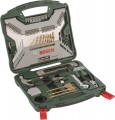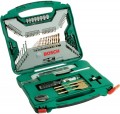Total number of items
The total number of core items included in the set.
In this case, the main items are all devices that are directly used during work: non-separable tools (traditional wrenches, hammers, pliers ...), elements of collapsible tools (for example, a ratchet for removable heads and 5 such heads will be considered 6 units) , as well as accessories (such as extensions or universal joints). Additional accessories — such as lights — may or may not be included in this count, depending on the manufacturer; however, there are usually few such accessories, and they do not fundamentally affect the total number of items.
The most modest modern tool kits include
up to 25 units. However, such kits are very popular — they are inexpensive and at the same time can be very versatile.
25 – 50 items is still quite a small number,
50 – 75 pcs can be called an average,
76 – 100 items are more than average, and the most extensive modern sets can include
100 – 150 items or even
more.
The general rules for choosing this parameter are obvious: a more extensive set, usually, is more multifunctional, but more expensive, weighs more and takes up more space. It is also worth bearing in mind that with a similar number of items, the specific assortment of these items in differ
...ent sets may be different; so when choosing, it is worth specifying not only the number of tools, but also their specific composition.Bit sizes
Varieties of bits (see above) included in the set.
Note that this paragraph specifies not just the size, but also the type of slot for which this or that bit is designed. This type is indicated by a letter index followed by a number describing the size — for example, SL5. Here are the most popular designations found in modern bits:
— SL. Flat bits for straight slot. The size is indicated in millimetres.
— Ph. Classic cross bits. The size is indicated by a conditional number.
— P.Z. Bits for a modified cross slot with improved engagement, have additional edges. The size is indicated by a conditional number.
— TX, T. Torx bits, with six-pointed sprocket tips. The size is indicated by a conditional number.
— H. Hex bits, with hex tips. The size is indicated in millimetres.
If there is more than one bit of a certain type in the set, the number is specified after the designation, for example, PH2x2.
Screwdriver handle
Number of
screwdriver handles supplied with the tool kit.
Such handles, in fact, are screwdrivers without a tip — in its place there is a seat for a bit. It can be either a square (see above) or a hexagon socket, often magnetic; in fact, the presence of more than one handle in the kit is typical mainly for cases where different types of fasteners are used. Also note that, in addition to fixed mounts, in which the bit is fixed rigidly, there are also reversible devices — with a ratchet mechanism, similar in operation to ratchets (see above).
Theoretically, bits can be used with other types of tools — for example, the ratchets described above — and in many sets this possibility is directly provided. At the same time, it is work in the format of a screwdriver that is considered the classic option, and often it is he who is optimal.
Adjustable wrench
Adjustable wrenches are all types of wrenches in which the distance between the jaws (that is, the working size) can be changed at the request of the user. The most famous type of such a tool is open-end wrenches (see above), in which one sponge is made movable and moves using a characteristic worm mechanism; colloquially, they are sometimes referred to as plumbing. Also referred to as adjustable are the so-called gas or pipe wrenches. Their jaws are located at an angle to the handle, and the mechanism is designed in such a way that the key not only adheres to the fastener, but also compresses it. Both varieties are quite common, so before purchasing a set of tools with an adjustable wrench, it would be useful to clarify the type of this wrench.
Note that the range of adjustment of such tools is quite extensive. In one fixture, it may well cover almost all sizes of fasteners found both in everyday life and in many areas of professional use (with the exception of perhaps the smallest or largest — but other tools can be provided for them). Therefore, usually, it does not make sense to include more than one wrench in the delivery set.
Hammer
Number of
hammers supplied with the tool kit.
Most often, modern sets include the so-called locksmith hammers, in which the base of the head has a square section, and two strikers are provided — on the one hand, flat, for the entire width of the head, on the other, narrowed, but not pointed (also called "sock"). This shape promotes optimal balance, and the toe box can be used to work in narrow spaces and some specific tasks like splitting stone. In turn, the main striker is well suited not only for driving nails, but also for straightening sheet metal (as an impromptu alternative to a mallet).
Somewhat less frequently, carpenter's hammers are supplied with tool kits. They have a round striker, and on the opposite side there is a characteristic “fork” intended for use as a nail puller. Other, more specific types of hammers are practically not used in this case.
In general, both carpentry and locksmith hammers are versatile enough that most modern tool kits provide only 1 hammer (if any). There are exceptions — in some extensive professional kits; however, even in them, the number of hammers usually does not exceed 2.
Pliers
Number of
pliers supplied in the kit.
Initially, pliers are a device for holding, manipulating and squeezing various parts, having two handles and two characteristic flat jaws (hence the name). However, in the case of tool sets, this term often means a more functional device — pliers. Modern pliers, in addition to the flat part, have the following equipment:
— one or two recesses on the jaws, allowing you to capture pipes and other round / polyhedral parts;
— a pair of blades that allows you to use the tool as wire cutters;
— devices for cutting wire from the outside of the jaws (usually on both sides).
In most modern tool kits, only one pliers are provided, and, usually, these are pliers — thanks to the extensive capabilities of such products, such equipment is most often quite sufficient. However, there are also exceptions to this rule. In such cases, additional pliers can be both smaller pliers and other types of tools; this point should be clarified separately, and the options may be as follows:
— actually pliers of a traditional design, without additional equipment;
— thin-nosed pliers with long, elongated jaws, well suited for delicate work;
— round-nose pliers — with round-shaped jaws, used, in particular, for bending wire and other parts.
Tape measure
Roulette included. The length of most modern
tape measures is 3 – 5 m — this is quite enough for most cases, while the weight and dimensions of the case remain small and allow you to conveniently take measurements.
Weight
The total weight of the tool kit. Indicated with a case, stand or other storage/transportation device (see Tool Storage). First of all, you should pay attention to this parameter if you plan to often carry the kit over long distances — the lighter the weight, the easier it will be to do. At the same time, extensive sets inevitably turn out to be weighty.

